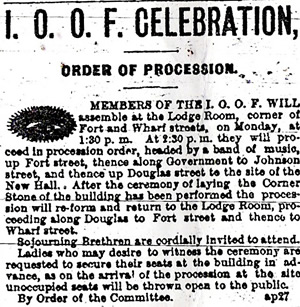The Ceremony

As the ad for the ceremony of April 29, 1879 suggests, the ‘ladies’ of the day arrived early at the lot on Douglas street to anticipate the entrance of parading Lodge officials.7 A band was the first to reach the site, followed by Victoria’s Masons and visiting Brethren. Noted by the officiating Grand Master of the Grand Lodge of British Columbia, the cornerstone laying ceremony represented an auspicious beginning to the construction of the hall.8 A grand ceremony was only fitting for a grandiose venture: the ambitious nature of the architectural plans, prepared by John Teague, promised it to be one of the most prominent buildings in the city.9 A copper box, full of votive deposits typical of the period (such as coins and papers) was laid with the cornerstone in commemoration of the day.
The Odd Fellows cornerstone ceremony, much like the cornerstone ceremony of the Masonic fraternity, relied on symbolic reference to Lodge custom and practice. Water, flowers, and wheat were sprinkled upon the stone, representing Friendship, Love, and Truth.10 These three pinnacle principles have bound members of the I.O.O.F. together through time, as signified by the fraternal emblem of three chain links. Today, these same principles allow historians to critically examine the nature of colonial culture during the Victorian time period. The ad below, published in January of 1879, indicates that the manifestation of Friendship, Love, and Truth in the city of Victoria was influenced by ideologies and beliefs of race, morality, supremacy, and entitlement.“…The foundation stone will be laid with appropriate ceremonies on the anniversary of the introduction of Oddfellowship into America…No Chinamen are to be employed on the works or any bricks made by Chinese used in the building.” -Daily British Colonist, January 7, 187911
As historians who try to understand how the past shapes the present, we aspire to acknowledge and consider the competing complexities of race, class, gender, and politics. If the topic of cornerstones and time capsules appears benign at first glance, the quote above suggests that these civic ceremonies and associated endeavours were imbued with all of the colonial politics that existed in Victorian Victoria.Article Two of the I.O.O.F. Constitution and By-Laws of Victoria Lodge No. 1, published in 1878, states that “All candidates for initiation must be free white males, of the age of twenty-one years and upwards, of sound health, of good moral character and industrious habits, having some respectable known means of support, and believe in the existence of a Supreme Being…”12 Despite the influence of a new cultural and environmental landscape, Victoria’s colonists retained an ethos of British supremacy. While the 1878 Constitution of the Odd Fellows reflects a strong racial suspicion against non-white residents, much of Victorian society did, too.13
Click here to learn about the I.O.O.F. Time Capsule
Click here to learn about Charles Gowen
Return to I.O.O.F. Main Page
View References for this Page






